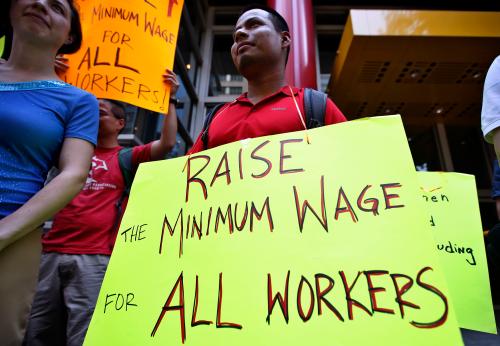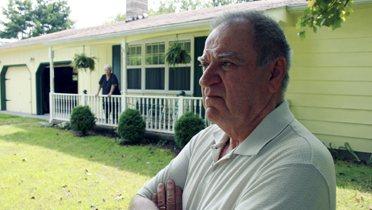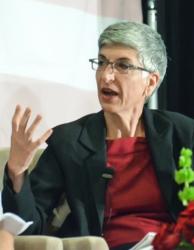This piece was originally published on Spotlight on Poverty and Opportunity on October 4, 2017.
We recently traveled together to the heartland – the western Ohio River Valley – to meet working-class Americans. We saw a lot of pain: dislocated workers, economic stagnation, drug addiction, family breakdown, community breakdown. But we also returned with some reasons for hope – about the working class itself and local institutions that serve it.
We’re part of a diverse study group sponsored by three organizations – Opportunity America, the Brookings Institution and the American Enterprise Institute – that’s working over the course of a year to develop policy solutions for the working class. This early report reflects our impressions, not necessarily those of the entire group.
The group is steeped in research – the best available data, the latest evidence on what works – and we’ll be drawing on that later as we debate solutions for the working class. But we wanted to do some legwork first: to meet some ordinary people and get a feel for their communities. And we chose the Louisville metro area – western Kentucky, southern Indiana – because we thought it would offer us a good cross section of white and black working-class Americans.
We were in the region only a few days but covered a lot of ground. We met a group of workers laid off a year ago when a food-processing plant closed its doors after more than 50 years as one of the town’s main employers. We visited a drug treatment center where we met a single mother holding her infant son: he was on track to spend the first year of his life living with her in a residential 12-step program. At another treatment center, we attended a remarkable meeting where 80 former addicts – all men, white, black and Latino, aged 18 to 50 plus – held each other accountable for their behavior over the past few days.
Just a few blocks away, we visited a community college that trains recent high school graduates to work as maintenance technicians in advanced manufacturing plants. At another place, we met a group of workers – men and women, black and white – struggling to get by on low-wage or part-time work whose lives could be thrown into disarray by an unexpected expense like a child getting sick or a truck needing repairs.
We came away with a lot of respect for the professionals we met – some local government officials, many in the nonprofit sector. Most of the programs we visited were small. We did no formal evaluations and saw scant data. But we were taken by the spirit of the staff almost everywhere we went: dedicated people, caring and concerned, sometimes tough – teaching clients higher standards or new expectations for themselves – and often developing what struck us as innovative, pragmatic solutions.
The opioid epidemic and other forms of addiction may be an even bigger problem than we thought: so deeply rooted, so tenacious, so devastating not just to addicts but also to everyone around them
The two drug treatment facilities we visited were very different. One smoothed the way to sobriety with medication; the other used a strictly “social” as opposed to “medical” approach. But staff at both places seemed to share a conviction that physical addiction can be addressed only when a person is ready and in an intensive, supportive program. The tools of choice at both facilities: the 12-step model and cognitive behavior modification. Both programs expected clients to remain in their care for an extended period – months if not years – before making a difficult transition to living independently. The demand for services greatly exceeds supply, and many clients who relapse must return a second or third time before they succeed.
Our top takeaway was that the opioid epidemic and other forms of addiction may be an even bigger problem than we thought: so deeply rooted, so tenacious, so devastating not just to addicts but also to everyone around them – and often requiring expensive, long-term care. When we asked about prevention, most professionals seemed to throw up their hands – there aren’t many effective tools. But we came away eager to learn more about regulation of prescription painkillers. And we wondered about the wisdom of full-on legalization of marijuana as opposed to decriminalization. As we learned in Louisville, for those vulnerable to addiction, the specific substance may not matter – they’re inclined to take whatever is available.
We talked to professionals from several programs that teach workforce skills, and in that case too, it was clear: one size does not fit all. Some programs are designed mostly for students fresh out of high school who aren’t likely to succeed at a four-year college but are looking for well-paying careers. Other interventions target older workers who made the wrong choices the first time around or who have been displaced by economic change. Some occupations take longer to prepare for than others, some training is more thorough, and there’s a need for all of the above: from intensive, long-term apprenticeship programs that teach both hard and soft skills and prepare young people for lifelong careers to short-term, down-and-dirty technical-skills training that helps experienced workers switch to a new technology or different industry.
That said, we were particularly impressed by one program we visited: the advanced manufacturing technician, or AMT, training pioneered at Toyota’s giant Kentucky plant and now in use across the state and beyond by some 305 manufacturing firms. It resembles an apprenticeship. Students spend two years combining classroom work with hands-on, on-the-job learning. Soft skills – getting to work on time, dressing appropriately, taking initiative – are as much a focus as technical training. Students get paid to participate in the program and usually, when it ends, take a full-time job with a sponsoring employer. But what makes Toyota AMT and its statewide offspring, KY FAME, distinctive is the degree to which employers are in the driver’s seat.
Though generally delivered at a community college, the curriculum was developed by employers – Toyota and a small group of others – and the program is administered across the state by a network of local employer chapters. Usually 10 to 20 firms, some big, some small, they work together to choose a community college and develop a working relationship with faculty, often demanding significant changes in how the school delivers learning. The employers also recruit students, pay them part- or full-time and mentor them three days a week on the job.
The program is designed to pay for itself, with employers covering all the cost. Students’ salaries are calculated to equal their education costs and sometimes more, so there’s little need for additional government involvement – no more than Washington already spends to fund equipment and other basics at the community college. The employer groups also engage with local K-12 educators – high schools, middle schools, even K-5 – encouraging and supporting STEM education. Students emerge from the program debt-free and in a position to command starting salaries of $50,000 to $75,000 a year. And some go on, with their employer’s help, to bachelor’s programs in business or engineering.
Our takeaway: though spreading fast, KY FAME is still small, and the program is not for everyone. Admissions criteria are steep. Not all employers can or will engage with this intensity. Not every occupation needs this level of training. And as with apprenticeship, it would be a mistake for policymakers to focus in on this model and this model only. Still, we’ll be watching with interest in coming months as a variety of Kentucky employers in other sectors – IT, health care, business services – endeavor to adapt and apply the model in their industries.
Our trip was over much too soon, and our group is a long way from agreeing on a slate of bipartisan solutions for the working class. But we came away with much food for thought – and not only about opioids and workforce development.
The people we met complained a lot about benefits cliffs – how government benefits drop off abruptly when beneficiaries take a job or get a raise – and we want to give some thought to the timing of that process. We heard about a wage insurance program designed to help workers when factories close under pressure from foreign trade. The government creates an incentive to get a new job quickly, even if it pays less, by temporarily paying part of the difference between the worker’s old wage and his new, lower salary. Our reaction: if this works, why not a larger wage insurance program, unlinked to trade? Meanwhile, almost everywhere we went, people complained about the delivery of public services: the red tape, the run-arounds, the bureaucratic complexity and lack of empathy or help. Surely, we as a nation can make some dent in that.
The wounds go deep across working-class America. Still, even the people in the worst shape struck us as remarkably resilient.
But in the end, what struck us most was less the programs we saw than the people we met. We knew going in but were still surprised by the diversity of the working class, which our study group defines as people with a high school diploma but no four-year degree, between the 20th and 50th earnings percentiles. In the western Ohio River Valley, they are all races, all ages, working and not working and more varied in origin and outlook than we could have imagined.
They aren’t as a group very interested in politics. Most are too absorbed in their own struggles to have time for that. And while many grumble about government – a distant, uncaring “they” – most don’t seem to be looking primarily to government for solutions. Many of their problems seem rooted in family breakdown – the erosion of marriage, single parenthood, mothers who live from boyfriend to boyfriend. It may be even more important than economic dislocation, and it’s often what’s behind inadequate working-class incomes.
The wounds go deep across working-class America. Still, even the people in the worst shape struck us as remarkably resilient. The single mother of three, just getting by on a clerical worker’s wage, who never misses a day at work and somehow makes ends meet even when unexpected expenses arise. The former addict struggling to stay clean, holding down a steady job and launching his own small business. The laid-off factory worker who took a lower-paying job in a dirty, dangerous plant much further from his home but who is now clawing his way back to his more robust former salary.
This grit and strength doesn’t mean the rest of us shouldn’t help. On the contrary, it was hard in many cases not to feel that we as a nation have failed the working class and that they need better solutions from both the private and public sectors.
Bottom line, everything we saw in the Ohio River Valley reinforced our belief that people who work hard and play by the rules – and can find the strength of character to help themselves even when their lives fall apart – deserve a little more help and respect from the rest of us.








Commentary
Visiting working class America
October 11, 2017